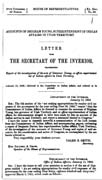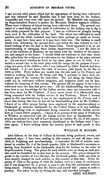
[p. 1]
37th Congress 2nd Session House of Representatives Ex. Doc. No. 29
Accounts of Brigham Young, Superintendent of Indian Affairs in Utah Territory
Letter From The Secretary of the Interior, Transmitting Report of the investigation of the acts of Governor Young, ex officio superintendent of Indian affairs in Utah Territory.
January 15, 1862 Referred to the Committee on Indian Affairs and ordered to be printed.
Department of the Interior,
January 13, 1862
SIR: The 6th section of the “act making appropriations for sundry civil expenses of the government for the year ending June 30, 1862,” enacts “that the Commissioner of Indian Affairs be directed to examine the accounts of Brigham Young, late governor of Utah Territory, and ex officio superintendent of Indian affairs, for disbursements alleged to have been made by him on account of the Indian service in said Territory, and report a statement thereof to Congress.”
I have the honor to transmit herewith a communication of the 11th instant from the Commissioner of Indian Affairs, and accompanying papers, embracing a report of Benjamin Davies, late superintendent Indian affairs, Utah Territory, of his investigation of the accounts of Governor Young, and copies of said accounts, for the consideration and action of Congress, as contemplated by the act herein referred to.
Very respectfully, your obedient servant, CALEB B. SMITH, Secretary Hon. Galusha A. Grow, Speaker of the House of Representatives

[p. 29]
William H. Rogers, of lawful age, being produced, sworn, and examined, states: I came into this Territory in August, 1858. I am an agent in the Indian service in Utah Territory at the present time, and have been for more than eighteen months. I have no knowledge of the value of services performed for the Indian service in Utah Territory in 1856 and 1857. I have no knowledge of the value of such services in 1858. I have no knowledge of the prices of such articles as were generally distributed among the Indians as presents at that time. From what I have learned from the former agents and from common report, the Indians in this Territory were always in a bad condition, without much variation, up to the present time. In the spring of 1859 I accompanied Superintendent Forney, on an expedition to recover the children who survived the Mountain Meadow massacre, to the southern part of this Territory, to the Santa Clara settlement. At Jacob's Twist, on the Santa Clara, I saw the remnant of a dam which I was informed by Mr. Jacob Hamblin had been built for the Indians for purposes of irrigation. I also saw, some three or four hundred yards below, three or four acres of land which had been in cultivation the year previous, which I learned from Mr. Hamblin had been cultivated by the Indians.

[p. 30]
I saw several other places which had the appearance of having been cultivated, and was informed by said Hamblin that it had been done by the Indians. Cornstalks and vines were still upon the ground. Mr. Hamblin was employed by Superintendent Forney to gather the Mountain Meadow massacre children. There were evidence of wheat having been cultivated there. The ground consisted of a sand-bank, and the mode of cultivation by the Indians was to dig it with sticks prepared for that purpose. I saw no evidences of ploughs having been used in the cultivation of the land. The wheat was cultivated in small patches, and the whole included may have been perhaps as much as twenty acres. It may have been more or it may have been less. The Indians in small bands were cultivating the ground above and below the dam referred to, but I heard nothing of but one dam in the Santa Clara. There appeared to be no one superintending or managing there Indian improvements. I saw Mr. John D. Lee at his residence at Harmony on our return with the children of the massacre and camped at his house. I should think his residence at that time about fifty miles from the evidences of cultivation by the Indians at the place referred to. Do not know whether he lived in the same place or not in 1856. I returned a second time to the same place with troops, for the purpose of recovering two more of the children, who I was informed by Chief Kanosh had been left behind. I do not know the value of services paid hands by the day in 1856 or 1859. Forty dollars per month was the rate paid by Dr. Forney and board to working hands on the farms, and that I presume to have been the current price of the country for such labor. The soil along the Santa Clara could not be cultivated without irrigation, and irrigation could not be done without the damming of that stream. The ground did not appear to have been cultivated since the dam had given way. All the blacksmithing that has been done here to my knowledge for the Indian service since my connexion with it has been done by Mr. Cuthbert. I have never heard of a blacksmith shop being connected with the Indian service in this Territory. Before I became agent in this superintendency I was in the employment of Dr. Forney, and I know that during that time he had all his blacksmithing done by Mr. Cuthbert. I know of no other person having been employed by the superintendency as blacksmith or assistant blacksmith for the United States, or of any building for blacksmithing tools or implements being connected with the Indian service here as United States property. I know of no persons of the name of Pendleton or Whiston as connected with the Indian service here as blacksmiths. The articles mentioned in the bill of Levi Stewart, in voucher No. 13, of 4th quarter, 1856, are such as have been commonly distributed to the Indians since I have been agent. I know nothing about the current prices of such goods at that time.
WILLIAM H. ROGERS